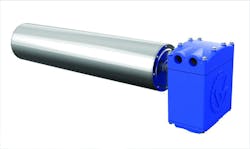Motor Consumes Less Energy
Show Daily Exclusive - Conveyor users and conveyor manufacturers have accepted the drum motor as the most efficient way to drive belt conveyors. With no external motor and gearbox, the drum motor saves space, eliminates the need for scheduled maintenance and enhances operator safety.
However, the challenge has been the ease and ability to adjust belt speed as plant processing requirements change. This is achieved via a frequency inverter (VFD), which often is located in a control room some distance away from the conveyor drive electric motor.
With the Van der Graaf Intelligent Drum Motor design, the rotor is magnetically self-induced by the use of permanent magnets installed on the rotor body. Lab test results show electrical savings of up to 72% vs. a conventional motor/gearbox conveyor drive.
The Intelligent Drum Motor requires a sensorless vector control to operate, and due to this requirement, must be used with the integrated VFD. The integrated VFD is EtherNet/IP and MODBUS compatible and enables communication with other plant equipment. It also can provide conveyor drive data feedback and control belt speed either remotely or directly at the drum motor. The combination of the rotor with permanent magnets and the integrated VFD, distinguishes the Intelligent Drum Motor from a standard drum motor.
The Intelligent Drum Motor simplifies the selection of belt speed without loss of torque or belt-pull, substantially increasing the efficiency and the life of the electric motor, further minimizing downtime and decreasing overall operating costs.
For more information, visit www.vandergraaf.com. SD

